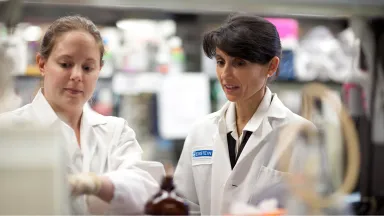
U. Thomas Meier, Ph.D.
- Professor, Department of Cell Biology
Area of research
- Nuclear function and organization: small nucleolar ribonucleoproteins (snoRNPs) and their involvement in inherited disease and cancer. Human reproduction: endometrial receptivity.
Phone
Location
- Albert Einstein College of Medicine Jack and Pearl Resnick Campus 1300 Morris Park Avenue Forchheimer Building 650 Bronx, NY 10461
Research Profiles
Professional Interests
All ribosomal and other stable RNAs are heavily modified by small nucleolar ribonucleoproteins (snoRNPs). We are studying these processes and how they contribute to the formation of the nucleolus and other nuclear organelles through phase separation. Amino acid substitutions in some of the snoRNP proteins cause genetic diseases, e.g., the bone marrow failure syndrome dyskeratosis congenita with a predisposition to cancer. We are investigating the mechanisms underlying these diseases on a cellular level.
SnoRNPs rely on short guide RNAs to specify nucleotides for modification in target RNAs. There are two major classes of snoRNAs, H/ACA and C/D, guiding pseudouridylation (ψ) and 2’-O-methylation (CH3) of RNA, respectively. Each of these several hundred RNAs are stabilized by the same four snoRNP core proteins for each class. Some of the core proteins share similar intrinsically disordered domains (IDRs), that are highly charged and rich in nuclear localization signals (NLSs) or glycine-arginine-rich (GAR). The nucleolar snoRNP chaperone Nopp140 binds to both the NLS and GAR IDRs of the snoRNP core proteins. Additionally, we identified a similar charged NLS IDR in the C-terminal tail of the RNA polymerase I subunit PAF49 that also binds to Nopp140 and can mediate interaction with snoRNPs. Since RNA polymerase I exclusively transcribes ribosomal DNA, this interaction network links the rRNA modification machinery to rDNA transcription explaining the cotranscriptional modification of rRNA. All these reactions and interactions occur in the densely packed yet highly dynamic dense fibrillar component (DFC) of the nucleolus. Transmission electron micrographs of wild type, Nopp140 knockdown and rescue cells confirm that the dense organization of the DFC depends on the presence of Nopp140. We are analyzing this phase separated organelle in vitro and in vivo to understand the basic mechanism of ribosome biogenesis.
We are also investigating the roles of snoRNPs and Nopp140 in other nuclear phase separated bodies, Cajal bodies, where they modify spliceosomal small nuclear RNAs (snRNAs), required for pre-mRNA splicing, and where they stabilize telomerase RNA, required for telomere length maintenance.
Finally, we study the function of nucleolar channel systems (NCSs) in human reproduction. NCSs are micron-sized membranous organelles in the normally membrane-free nucleus. During each menstrual cycle, they transiently develop during the height of receptivity in endometrial epithelial cells. NCSs are implicated in the preparation of the endometrium for uterine attachment of the fertilized egg. We identified molecular markers for NCSs and exploit them to understand the cellular biology of these enigmatic organelles and their regulation and function in uterine biology, e.g., the timing of embryo transfer in in vitro fertilization cycles to boost IVF success rates.
Selected Publications
Meier, U.T. (2022) The daunting task of modifying ribosomal RNA. RNA 28:1555-1557.
Meier, U.T. (2022) Guide RNA acrobatics: the one-for-two shuffle. Genes Dev 36: 1-3.
Bizarro, J., Deryusheva, S., Wacheul, L., Gupta, V., Ernst, F.G.M., Lafontaine, D.L.J., Gall, J.G., and Meier, U.T. (2021). Nopp140-chaperoned 2’-O-methylation of small nuclear RNAs in Cajal bodies ensures splicing fidelity. Genes Dev 35: 1123-1141.
Gerber, R.S., Buyuk, E., Zapantis, G., Lieman, H., and Meier, U.T. (2021). Presence of endometrial nucleolar channel systems at the time of frozen embryo transfer in hormone replacement cycles with successful implantation. F S Sci 2, 80–87.
Bizarro, J., Bhardwaj, A., Smith, S., and Meier, U.T. (2019) Nopp140-mediated concentration of telomerase in Cajal bodies regulates telomere length. Mol Biol Cell 30: 3136-3150.
Meng, F., Zapantis, G., Williams, S.Z., Lieman, H.J., Buyuk, E., and Meier, U.T. (2018) The status of nucleolar channel systems in uterine secretions accurately reflects their prevalence – a marker for the window of implantation – in simultaneously obtained endometrial biopsies. Fertil Steril 109: 165-171.
Bizarro, J. and Meier, U.T. (2017) Inherited SHQ1 mutations impair interaction with NAP57/dyskerin, a major target in dyskeratosis congenita. Mol Genet Genomic Med 5: 805-808.
Meier, U.T. (2016) RNA modification in Cajal bodies. RNA Biol 10:1–8.
Yu, Y.-T. and Meier, U.T. (2014) RNA-guided isomerization of uridine to pseudouridine – pseudouridylation. RNA Biol 11: 1483–1494.
Nejat, E.J., Ruiz-Alonso, M., Simón, C., and Meier, U.T. (2014) Timing the window of implantation by nucleolar channel system prevalence matches the accuracy of the endometrial receptivity array. Fertil. Steril. 102: 1477-1481.
Nejat, E.J., Szmyga M.J., Zapantis G., and Meier U.T. (2014) Progesterone Threshold Determines Nucleolar Channel System Formation in Human Endometrium. Reprod Sci. 21: 915–920.
Zapantis G, Szmyga MJ, Rybak E, and Meier U.T. (2013) Premature formation of nucleolar channel systems indicates advanced endometrial maturation following controlled ovarian hyperstimulation. Hum Reprod 28: 3292-3300.
Szmyga MJ, Rybak EA, Nejat EJ, Banks EH, Whitney KD, Polotsky AJ, Heller DS, and Meier U.T. (2013) Quantification of nucleolar channel systems: uniform presence throughout the upper endometrial cavity. Fertil Steril 99: 558–564.
Machado-Pinilla, R., Liger, D., Leulliot, N., and Meier, U.T. (2012) Mechanism of the AAA+ ATPases pontin and reptin in H/ACA RNP biogenesis. RNA 18: 1833–1845.
Walbott, H., Machado-Pinilla, R., Liger, D., Blaud, M., Rety, S., Grozdanov, P.N., Godin, K., van Tilbeurgh, H., Varani, G., Meier, U.T., and Leulliot, N. (2011) The H/ACA RNP assembly factor SHQ1 functions as an RNA mimic. Genes Dev 25: 2398–2408.
Meier, U.T. (2011) Pseudouridylation goes regulatory. EMBO J 30: 3-4.





